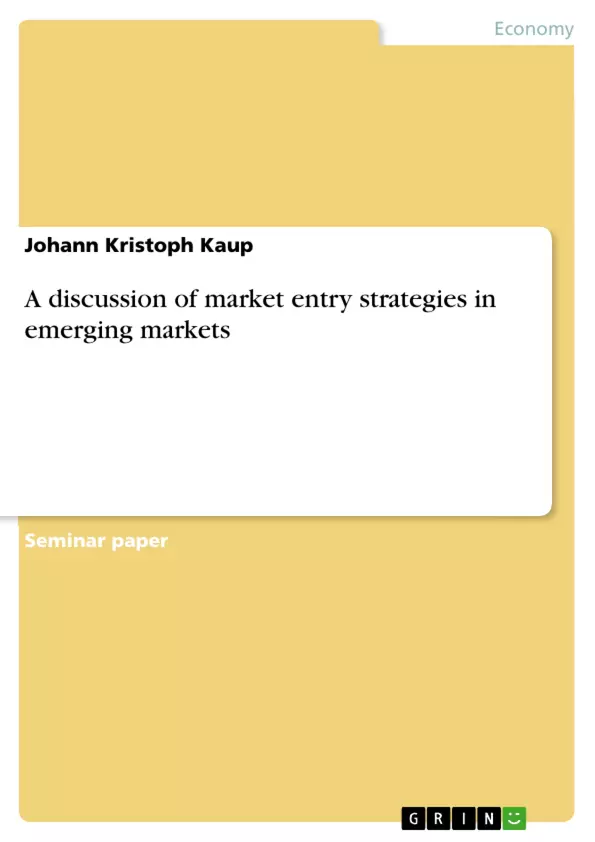This term paper shall give an overview of different options to enter an emerging market and indicate a company about identifying the most promising market entry strategy. Which factors determine the market entry strategy for an emerging market?
To answer these questions company and market specific factors in terms of emerging markets will be considered. E.g. company size, market potential or social and cultural differences might eliminate strategies already before. But are the chances opening up by entering an emerging market predominant and worth the risk?
Following the introduction, the second chapter provides definitions of emerging markets and developing countries. Furthermore it illustrates the characteristics of emerging markets on the basis of the BRIC countries. In Chapter three factors affecting the decision for a market entry strategy are displayed. Moreover this chapter includes chances and risks of entering emerging markets. Chapter four explains different market entry strategies which are then critically analysed with regard to the previous findings in chapter five. On this basis chapter six provides the conclusion including answers to the afore-mentioned questions.
Inhaltsverzeichnis (Table of Contents)
- Introduction
- Objective of the term paper
- Course of investigation
- Definition and characterisation of emerging markets
- Factors affecting the market entry strategy
- Internal factors
- External factors
- Chances and risks of entering emerging markets
- Market entry strategies
- Export
- Contractual
- Investment
- Critical analysis of market entry strategies for emerging markets
- Conclusion
Zielsetzung und Themenschwerpunkte (Objectives and Key Themes)
This term paper aims to provide an overview of different market entry strategies for emerging markets, helping companies identify the most promising option. It examines the factors that influence the choice of strategy, including company size, market potential, and social and cultural differences. The paper also explores the opportunities and risks associated with entering emerging markets.
- Defining and characterizing emerging markets
- Identifying factors influencing market entry strategies
- Analyzing the chances and risks of entering emerging markets
- Exploring different market entry strategies
- Critically evaluating the suitability of these strategies for emerging markets
Zusammenfassung der Kapitel (Chapter Summaries)
The introduction lays out the context of globalisation and the increasing importance of emerging markets. It outlines the objective of the term paper, which is to guide companies in selecting the most appropriate market entry strategy for emerging markets. Chapter two delves into definitions and characteristics of emerging markets, using the BRIC countries as examples. Chapter three focuses on factors influencing the choice of market entry strategy, covering both internal and external factors. It also examines the chances and risks associated with entering emerging markets. Chapter four explores different market entry strategies, such as export, contractual arrangements, and investment. Chapter five critically analyzes these strategies in relation to the findings of the previous chapters.
Schlüsselwörter (Keywords)
Emerging markets, market entry strategies, globalisation, BRIC countries, internal factors, external factors, chances, risks, export, contractual arrangements, investment, critical analysis.
- Quote paper
- B.A. Johann Kristoph Kaup (Author), 2016, A discussion of market entry strategies in emerging markets, Munich, GRIN Verlag, https://www.grin.com/document/429834



